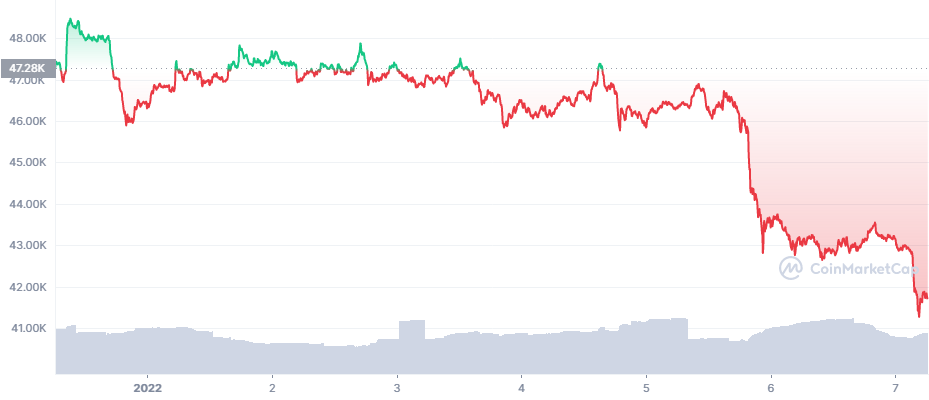Crypto Market Erases Q4 Rally

The cryptocurrency market is on track to return to overall valuations since before the rally in the last quarter of the year. The overall market capitalization for all digital assets almost touched $3 trillion, reaching the valuation of Apple, Inc. But the rally was cut short after a series of liquidations in December.
In the beginning of 2022, the cryptocurrency market is valued at about $1.98T, after another crash that erased up to 30% from the value of smaller assets. Bitcoin (BTC) slid to a low near $42,700 but later recovered to $43,000 late on Thursday. Ethereum (ETH) crashed to the $3,200 range and saw its dominance decline to under 20% of the total crypto market capitalization.
Within a day, the Crypto Fear and Greed Index fell to 15 points, showing extreme fear and a level similar to bigger liquidations. For the last time, the index was in this range during the May-June crash in 2021, and before that, the March 2020 crash.
The market panic follows a period of doubts on whether crypto assets would go for a bear market after an immensely successful year. The latest market slide happened during a period of neutral funding rate and a score of liquidations quite far from previous records.
How Low Can BTC Crash
The expectations for the recent downward trend see BTC crashing to as low as $40,000. The optimistic scenario is that after the correction, another rally may follow. The current market price or lower is already suggesting some buying potential based on the BTC Rainbow Chart.
Ahead of the weekend, BTC sank to $41,738.05, further pointing to a steady downward trend and possibly a revisit of levels under $40,000.
Panic selling can still deepen and be amplified by leverage, and smaller less liquid assets may be even more volatile.
Is BTC Mining Resilient
The Bitcoin network now has more than 14,000 nodes, up from a usual level of 10,000 in the past few years. The hashrate has also increased and has proven resilient to attempts at shutting down the network.
But some data showed about 300 to 500 nodes went down for some reason in the past 24 hours. One of the reasons may be the lost network connectivity in Kazakhstan following a blackout during anti-government protests in the country.
The BTC network remains resilient and the most widely accessed nodes are still located in the US and Europe, with significant hubs in Asia.
Hashrate reporting has not yet marked more significant anomalies or network slowdowns. Kazakhstan is one of the countries where Canaan Mining, one of the big mining farm companies, is expanding its activity. Uncertainty in the region may affect BTC mining in the longer term.
The BTC network even accelerated block production to under 10 minutes for a period on January 6. The different block time is usually not a problem for the network, with some anomalies for extended blocks or a much shorter block discovery time.
Is BTC Decoupled from Altcoins
The slide of BTC is affecting most altcoins. However, in 2022, most assets have their own USDT liquidity and are not directly linked to BTC.
Altcoin prices are more prone to corrections due to the relatively small liquidity in their trading pairs. Even outperforming assets like Solana (SOL) sank further, down to the $149 range. Axie Infinity (AXS), which held up close to $100, erased some of its value to the $75 range. Platform coins slid by more than 15%.
Can ETH Take Over
The Ethereum network starts another year in which it would have to attempt a shift to ETH 2.0. Currently, more than 8M tokens are forever staked on the ETH 2.0 smart contract, and they can only be moved when the network starts running based on proof of stake.
But more pessimistic predictions see ETH continue to be mined, with only partial updates taking the network closer to staking.
One of the big questions is whether ETH could become more significant in 2022 as BTC diminishes. A potential scenario for ETH and altcoins involves growth independent of BTC, with significant outperformance for some categories of assets.
ETH remains the go-to network for NFT mints and gaming. Even projects that migrated to other networks preserve an ETH version of their tokens.
Will SOL Recover
The SOL asset saw predictions of reaching $250 in the coming 12 months. One of the problems for the Solana network were some unexpected outages, often taking nearly 24 hours of no block production.
The Solana network stalled on two recent occasions, December 4 and December 10, 2021. The problems with the network are rare, but happen without a warning and undermine the reliability reputation of SOL.
Despite this, the Solana network is widely used for NFTs due to its lower fees.

Uphold makes buying crypto with popular currencies like USD, EUR and GBP very simple with its convenient options to swap between crypto, fiat, equities, and precious metals.

With over 50 coins and an obsession with security, Kraken is one of the safest places to buy and trade crypto.

Kraken has a good reputation for security and protection of your funds and operates across the USA (except NY), Canada, the EU and Japan

Based in Charleston, South Carolina. Serves over 184 countries and has done over $4 billion in transactions. Offers convenient options to swap between crypto, fiat, equities, and precious metals.

We are now paying prizes in Iota. Learn a bit about it and where you can buy, sell and store it

What is cryptocurency? What gives it value? How do you buy and store it? Beginners questions answered in plain English.

The leader in programmable money, smart contracts and decentralised applications. There have been many copycats but none have the community and level of adoption.

An early alternative to Bitcoin, LTC aimed to be a coin for easy, fast, low-fee spending. LTC offers a faster block time and a higher transaction capacity in comparison to Bitcoin.